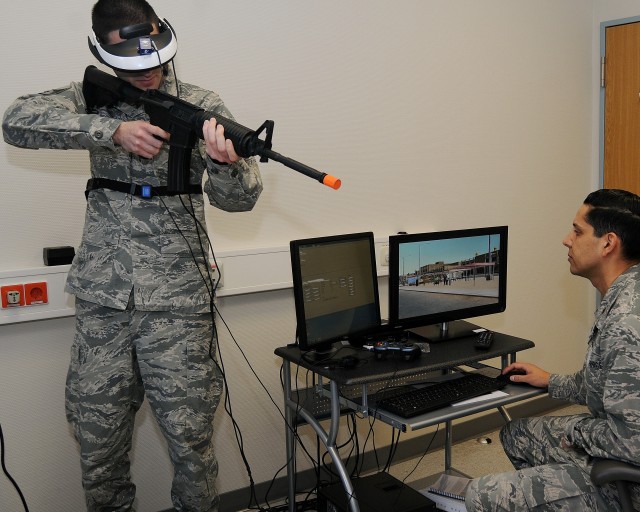
May 20, 2020 – The US Department of Defense (DoD) is looking into using virtual reality (VR) to support the enhancement of “small unit lethality”, and is seeking to solicit technologies from private industry, government research & development organizations, and academia for inclusion in an upcoming capability demonstration and experimentation event focused on the use of VR tools.
Titled ‘Thunderstorm 21-1’, the demonstration and experimentation event will focus on VR tools that leverage autonomy and artificial intelligence/machine learning (AI/ML) technologies capable of providing operators with ways to improve planning, decision making and efficiency; as well as reduce cost, workload, and risk; improve the safety of operators and operating equipment; and enhance situational awareness in both the rapid response planning and execution of small unit operations.
The Thunderstorm 21-1 event will primarily focus on developmental and mature technologies and will be structured to:
- Execute a variety of rapid response-related scenarios to examine the capabilities and limitations of VR tools to support planning and rehearsal of platoon level and other small unit operations. The scenarios will be designed in collaboration with the USMA and other interested federal government stakeholders;
- Invite industry, academia and government labs to demonstrate relevant capabilities by either providing end-to-end solutions or to propose a solution to one of the three components of the challenge:
- Collection
- Processing and VR Products Development
- VR Applications/Experience;
- Document the results with a level of granularity such that the reporting can inform future DoD investment decisions.
The DoD is inviting respondents to submit technology demonstration and experimentation applications related to an end-to-end solution, or to one or more of the following three capabilities:
1 – Collection capabilities that may include autonomous operations of air and ground systems: Unmanned Aerial System, Unmanned Ground Vehicle operating alone, as part of a group/swarm, or as a manned/unmanned team and capable of tactical photogrammetry and Measurement and Signature Intelligence collection to develop three-dimensional products (interior/exterior) in support of a platoon sized objective. Capabilities for this step may also include several other characteristics, such as:
- Low cost and disposable;
- On-board real-time analytics;
- Live streaming of data;
- Remote launch and recovery; and many more.
2 – Time Critical Processing under field conditions of data in step 1 to provide VR products in support of a platoon level mission, including Denied, Disrupted, Intermittent, and Limited (DDIL) bandwidth considerations. Desirable characteristics include:
- Capabilities that use low space, weight and power solutions;
- Local or private cloud;
- On premises processing;
- Ability to import and export to community defined standard formats.
3 – VR applications/experiences that may enhance a platoon or other small unit’s ability to rapidly gain situational awareness, complete their planning process and conduct mission rehearsals. The following characteristics are desirable:
- Intuitive, multi-user operational environments that virtually recreates a real-world location of interest that is representative of a current operational situation;
- Application that can ingest standard data formats;
- Distributed collaboration capabilities using shared virtual user experiences;
- Artificial Intelligence (AI) enabled representations of situations that the unit has never experienced;
- Capabilities to collect metrics and measures of effectiveness while a team is using a VR experience to demonstrate improvements in decision making;
- Geolocation-based data integration capability that enables current, proximal information to be represented virtually in situ.
The DoD states that after a review of applications, the government may invite candidates to demonstrate and experiment with their capability during the Thunderstorm 21-1 event, with the aim of the DoD’s investigation being to accelerate the delivery of innovative capabilities to US warfighters by demonstrating and experimenting with any capabilities that a VR tool might offer in an operationally relevant environment. In addition, candidates may be selected for follow-on events at facility specific locations in support of future acquisition activities. However, this doesn’t imply that the government will endorse, procure or purchase equipment at a later date.
The results will then be used to inform key decision makers of emerging and available technology solutions that could potentially enhance or improve operational capabilities.
Interested parties are able to submit applications to participate in the Thunderstorm 21-1 demonstration and experimentation event, which is planned for the autumn of 2020 at the United State Military Academy.
The application deadline is 5:00 PM EDT on June 19, 2020, and the event is planned to be conducted in the autumn of 2020 at the United States Military Academy (USMA) in West Point, New York.
For more information on how to submit an application please contact Auganix.
Image credit: U.S. Army
About the author
Sam is the Founder and Managing Editor of Auganix. With a background in research and report writing, he has been covering XR industry news for the past seven years.
